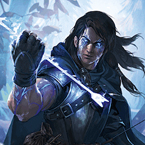In the history of Flesh and Blood, there's not been a hero more polarizing than Kano. Some players overly prepare for the match, while I've heard other players say they can concede and get a 50 minute break. You would think a hero that's been around for at least 4 years has been figured out by now, but Wizards continue to confound.
All classes play their own game. Warriors usually hits with weapons. Rangers fire arrows from arsenal. Runeblades have a delicate dance of sequencing different actions. Wizard is no exception here. The difference is the game they're playing requires a reframing of the game's mechanics.
Here, we'll take a dive into what makes Kano tick, so the next time you face a Kano, you'll have just a little more information and how to get through it!
Defense Against the Dark Arts
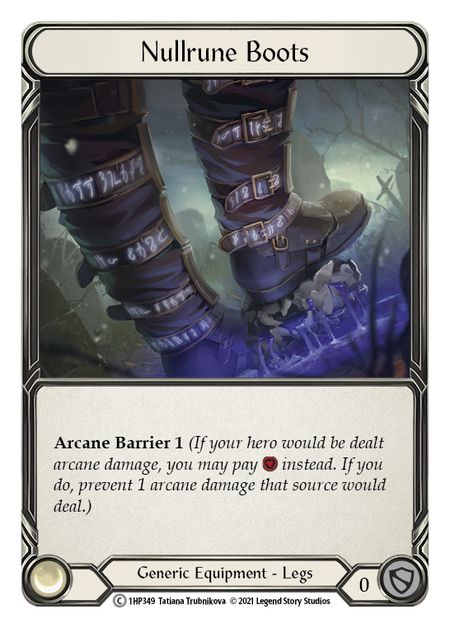
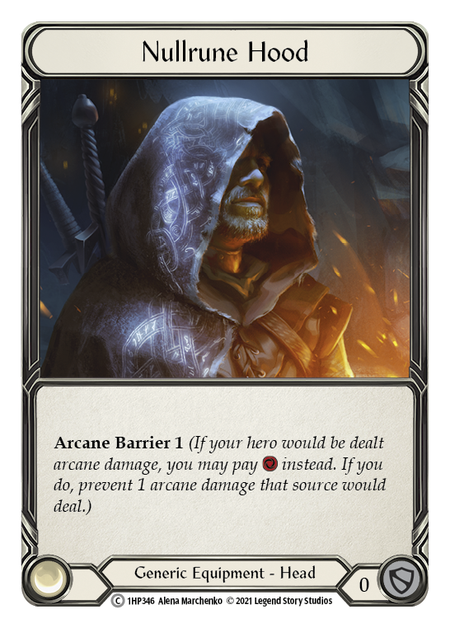
Let's start with defense. For anyone new to the concept, Arcane Barrier is how we “block” arcane damage - the most common being Nullrune equipment. It acts as a replacement effect which prevents the damage you would be dealt by the source in question. Your pitch is the key to utilizing this efficiently. Each Arcane Barrier can block 1 from a single source. If you are playing against a class like Runeblade, then Arcane Barrier 1 (AB1) should be sufficient to your needs. If multiple sources are dealing one arcane damage each to you then you only need AB1. If a single source of damage would deal 2 arcane, then you need AB2. You might find it helpful to conceptualize arcane damage from a single source as having dominate. The more AB you have, the more you can block from a single source.
If you are running a deck with all reds, AB3 will likely be too much. You'll spend just short of your hand to block any source of 3 damage. In this instance, you may consider (and test) your chances at racing Kano. He may still get an amazing draw and win the game, but this is the exception and not the rule.
AB2 can be plenty, but so can AB1. Prism will usually only run AB1 against Kano. This is effective for her because her angels all have Ward 4 when they are not in figment form. Boltyn will usually run mostly yellow cards, therefore anything higher than AB2 may not be healthy for him to run.
If you are running a deck full of blue cards then AB3 might be the way to go. There are reasons not to go beyond AB3. On a standard turn, Kano sends a red Aether Spindle at you for 5 damage. To prevent 4 damage, you would be getting rid of 2 cards. This will likely leave you with 2 cards left, making the Kano's math a little easier if he needs to respond on your turn. There are a few cases where AB4 can be useful. Playing Dash I/O, I want to feel comfortable breaking one of my pieces with Arcane Barrier if needed.
As a standard, I wouldn't pitch more than 1 card unless you had reason to. As for when to pitch and not to pitch? We'll cover that soon.
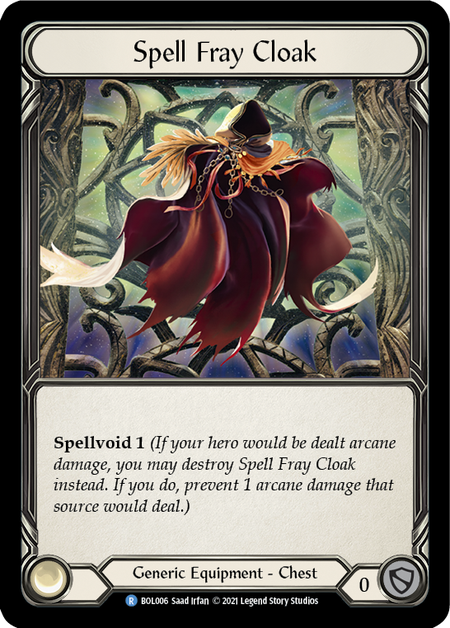
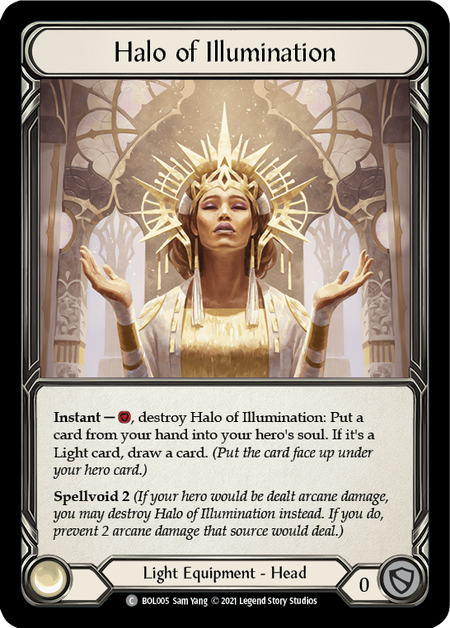
An alternative to Arcane Barrier is Spellvoid. There are items with Spellvoid such as Talisman of Dousing, but more common you'll see it as a keyword on equipment. Boltyn and Prism both run Halo of Illumination with Spellvoid 2 (SV2). Spell Fray equipment is generic equipment that can prevent 1 arcane damage. This is just another option for a healthy defense.
Know Your Spells
While there are several cards you'll see played by the Kano, let's talk about how to respond to them. Going through the entire card pool will take a while, so for now let's leave it to the top 6.
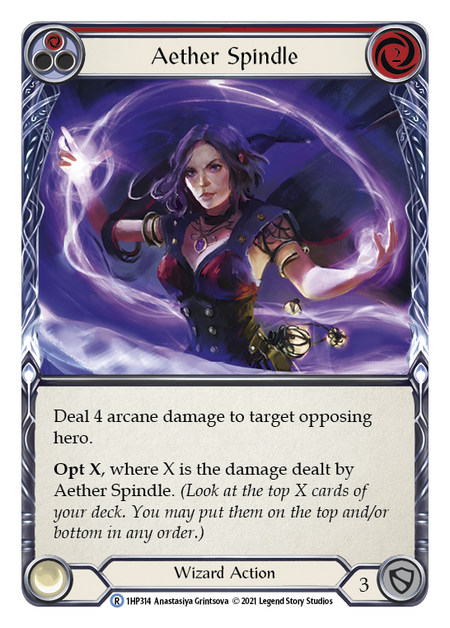
- Aether Spindle is a card that allows the Kano to opt as many cards as damage it deals. It comes in red at 4 damage, allowing Kano to sculpt their next hand. Prevent as much damage as practically possible.
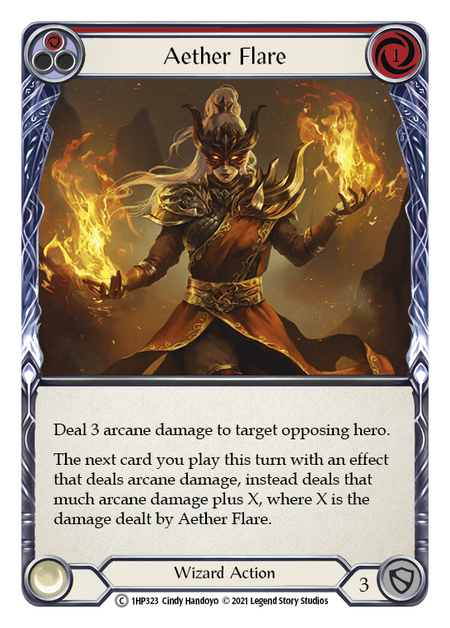
- Aether Flare will increase the damage of the next spell by how much damage it does. This card takes context to see if prevention is practical. The first of many questions to ask is “Does the Kano still have an action point?” You may also look to see if the Kano has more options. Is there another card in banish? Will you see anything else played by the Kano this turn? If you think another spell is incoming then you may choose to prevent damage from Aether Flare. If you think Kano will just send the Aether Flare then you can weigh the options of raw damage.
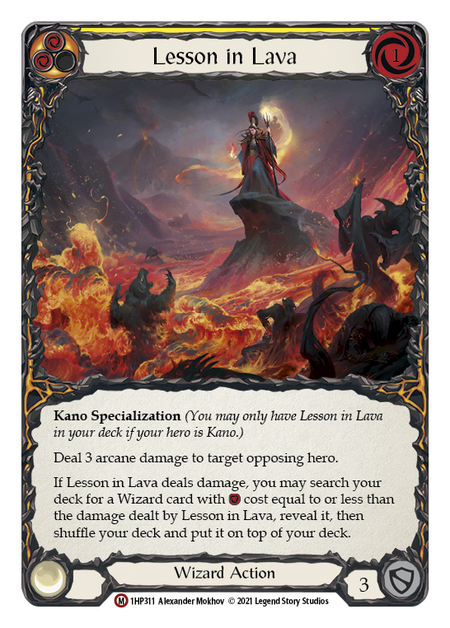
- Lesson In Lava allows you to tutor a card that costs less than the damage dealt by Lesson in Lava. If you think the Kano might be trying to manage a pitch stack, then they likely will not tutor off of Lesson. If Lesson deals at least 2 damage, then they could grab almost any Wizard non-attack from their deck. Immediately they may chose to put a Lesson in Lava on top; then they could do Lesson into Lesson into Blazing Aether and deal 12 damage. A Lesson to a Blazing could send 6 damage.

- Sonic Boom is an all-or-nothing card when it comes to prevention. Sonic Boom will come in standard for 3 damage. Sonic Boom provides a payoff by playing the card off the top of the deck if it's a Wizard non-attack action. The payoff could be great, but it could also be incredibly weak. Ultimately, if you can't prevent all of the card, then don't bother preventing any. If you know the next card on top of Kano's deck, then you may consider the options of AB. If Sonic Boom will hit a 2-cost action after dealing 3 damage, Kano will be able to play it for free.
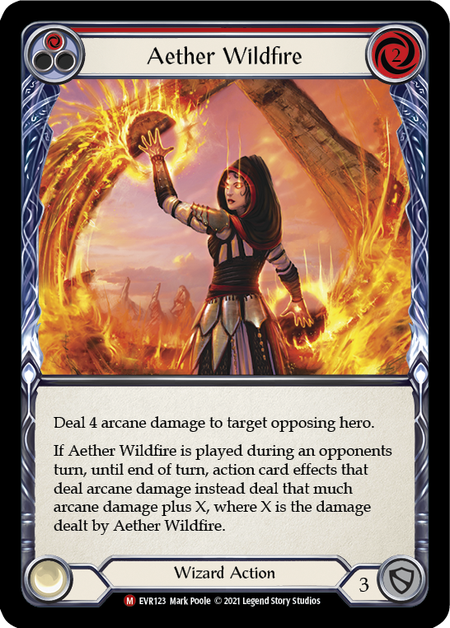
- Aether Wildfire is the the current buzz of the Kano match. It's a non-attack for 4 arcane damage. If it's played on Kano's turn, then there's no effect. If, however, it's played on the other hero's turn, then it will buff all action cards that deal arcane. This becomes exponential, as playing 3 action cards that deal 1 arcane apiece would hit for a total of 15 damage, assuming Wildfire hit for 4. If the effect for Wildfire is live, then you'll want to AB as much as you can.
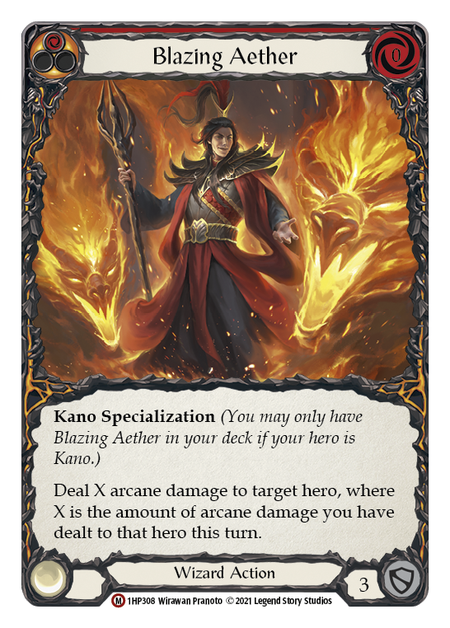
- Blazing Aether is an important endgame card to Kano's plan. While it doesn't present an "on-hit', it does present damage equal to all of the arcane damage taken by the opponent this turn. If the opponent has 10 damage, then playing Blazing Aether will deal another 10 damage in addition to what has already been done.
These are the big offenders and the cards you'll want to watch out for against Kano. While there are other cards you may consider, they typically will not have a ceiling as high as these.
Arcane Vigilance
You definitely want to take notice as Kano is playing out their turn. The reason for this is the ability to force you to AB. If you spend 1 card to prevent 3 damage on your turn, then that means you only have 3 cards left in hand. If you've already played 1 card, and pitched another, you've only got 1 card hidden from Kano.
Think of playing against Kano like handling your money. You have an allotted income to deal with any issues that arise throughout the day. If you use your cards (or spend your money) to deal with an issue that arises now, you will not have that option later. This is a standard strategy many Kano players will default to. If Kano is doing stuff at instant speed on their turn, they will still have an action point to play what's needed out of hand on their turn. Using an action point is the best way for the Kano to move forward.
The method many associate Kano with is playing on the opponent's turn - but most Kano players refuse to play on an opponents turn. A Kano pivoting to acting on your turn is not intent on catching you off guard or trying to be tricky. If they switch to this style they are presenting chip damage and preparing for a lethal turn to come. At best, they may be conditioning you to keep a certain amount of resources tucked away, sending meager-powered attacks. Playing on the opponent's turn is not a strategy that Kano should rely on for a large part of the match; doing this is considered sub-optimal because you will not present the opponent with the choice of using cards to prevent damage. When the opponent has less cards, it's less damage they can do on their turn.
While going through his deck, Kano is looking for Aether Wildfire to put into arsenal, potions to play, and to get any misses out of deck. Kano can go through his deck in a rather quick fashion. If he starts the game with 4 cards in hand, then pitches to activate Kano 4 times, he has then seen 8/60 cards. If he hits a Tome of Aetherwind, then he has already viewed 1/6th of his deck. Be mindful - in 5 turns, this Kano likely has all of the pieces he needs to make up some kind of combo. At that point, if he is just digging hard, he will have likely seen more than 40 cards in his deck. It wouldn't be hard to see more of his deck with the use of Tomes and the ability to Opt. If left unchecked, it won't take long at all to get all of the pieces Kano needs to be a powerhouse.
If you notice any signs that the Kano is setting up a pitch stack, then you will need to act accordingly. A Kano that reaches his second cycle will likely win the game regardless. As the opposing hero, your best strategy might be to set up for a large turn. A Kano who has blocked any attacks this turn will likely not be able to respond. Try to send as much damage as possible to prevent the stacking Kano. There are multiple ways the Kano will set up a second cycle turn. Some Kano's will use Defensive reactions such as Sink Below or Fate Foreseen to set up a pitch stack faster. Some may just choose to block with their hand, or with 3 cards and pitch one to a weapon, adding this card to the stack.
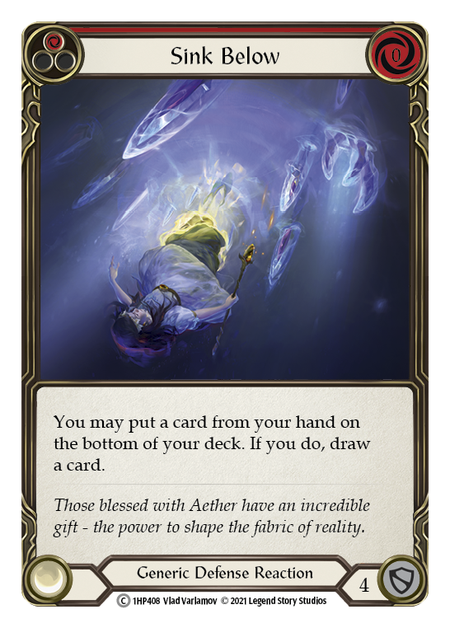
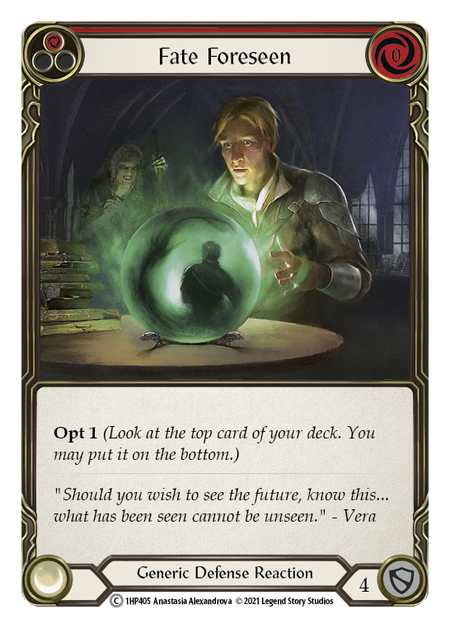
If you've ever sat down as or against a Kano, you'll realize quickly that he has less health than any of the other heroes. This makes blocking paramount as if you don't block you'll find your opponent can reach a critical point against your health quite quickly. The more Kano blocks to preserve life, the less utility he has on his own turn to send damage. There is a balance to find here. Furthermore, the Kano deck likely has cards with no block value - Potions, for example, or the newly revealed Kindle. The Kano will need to be conscious of cards that are not non-attacks; Kindle or other cards like Eye of Ophidia or Nourishing Emptiness can end their turn abruptly when they really need the opportunity to dig deeper into the deck. Imagine keeping 4 cards back, only to pitch to Kano on your turn and be hampered because the top card wasn't a non-attack action! Any card or effect that forces them to shuffle their deck will decrease their understanding of what they have left and shuffle any pitch stacking they may have done. Kano ultimately shines in constructed as a combo deck. This means he will need to utilize multiple cards to perform his best plan. Aside from these obstacles, he consumes significant mental energy to run.
What's Happening Inside?
This part isn't meant to scare you, but there is math AND memory involved in Kano's deck. While you aren't able to pitch stack against all of your matches (looking at you, Ninja and Kayo), it is still a good skill to have. There have been previous articles about Kano and stacking here on The Rathe Times. Check out a good one here! https://rathetimes.com/articles/pitch-perfect-learning-to-pitch-stack-with-kano
As a Kano, it's important you find ways to remember your deck or pitch stack. Some players may do different treatments of a card to help them establish the cycle. (Rainbow foil, non foil, and white border.) When they see the first variant they pitched, they know it's go time.
A friend of mine likes to do the “Person, Action, Object” strategy. When stacking, you try to make a sentence or a short story out of the cards in your stack. Each card in your deck has one of the three titles. Your first pitch is a Person, then action, then object. You may give different names to different colors of the same card OR you may even give the same name to cards that have similar functions. I.E. Sap and Prognosticate in blue are both 1 arcane damage. They may have the same words associated. To put it into practice for you, let's set an example:
Since the art on Chain Lightning is Kano shooting lightning from his hands you may name it as “Palpatine” for the person. “Shoots” for the action. “Lightning” for the object.
The Card Gaze the Ages may get “George” “Stares” “Eclipse”
Then let's say Blazing Aether is our next card. We would say “Kano” “Pets” “Dragons.
Then if we were to see the cards in sequence of Chain Lightning, Gaze the Ages, and Blazing Aether we would remember that “Palpatine Stares (at) Dragons”.
In the order of Gaze of the Ages, Blazing Aether, then Chain Lightning we would remember
“George Pets Lightning”
A tool to help understand this method further is a video from “Blazing for Lethal”: https://www.youtube.com/watch?v=aRC3wrpEzHc
The goal is to make a story out of your pitch stack and fun for you to remember!
Lastly, some Kano's will speak the language of Robots. 001100001111 While I am able to translate binary, I didn't really understand what this meant. Some Kano players like to assign binary to their pitch stack. 0=Meaning don't activate Kano's ability. 1= Do activate Kano's ability. The Kano players will then execute the code corresponding to their information.
Wizard Wear
It's important to understand Kano's optimal loadout for when he may start a match. They are as follows.
- Crucible of Aetherweave- This is the weapon of choice. It will pump arcane spells by a value of 1. It is an instant so you can play this at any time. Use this to make several of your spells come in at “break points” and increase your damage.
- Waning Moon- This weapon sends more damage but at the cost of playing a Non-Attack this turn. This is a great weapon of choice in the mirror AND against Prism.
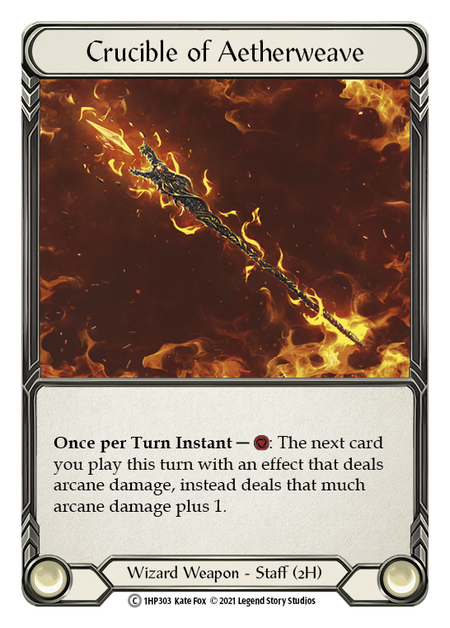
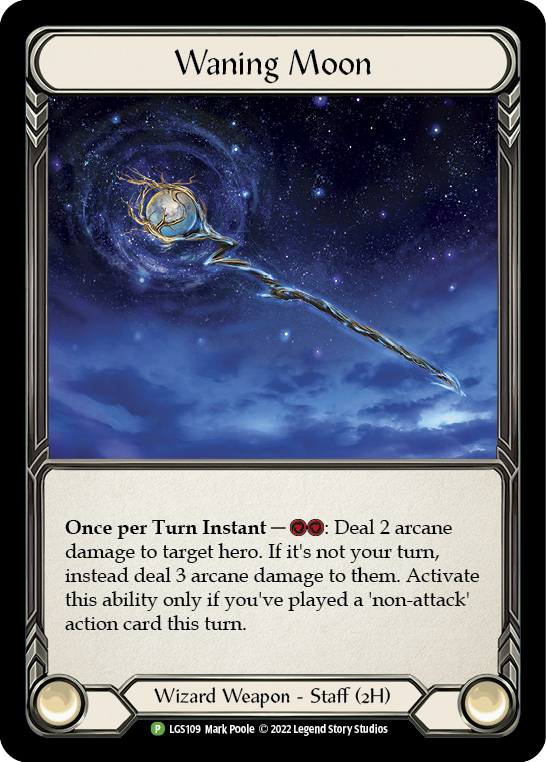
- Fyendal's Spring Tunic- If a game goes beyond 3 turns, then please use this. If you find yourself in a stack matchup this is also a great choice.
- Alluvion Constellas- Has arcane barrier. The effect of being able to activate a weapon for free makes it ideal in Kano mirrors.
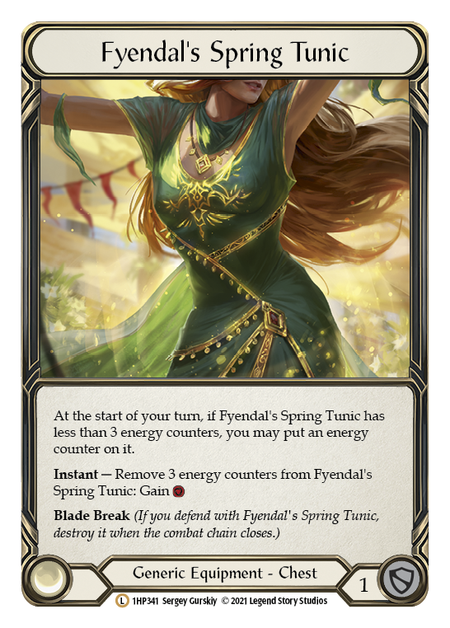
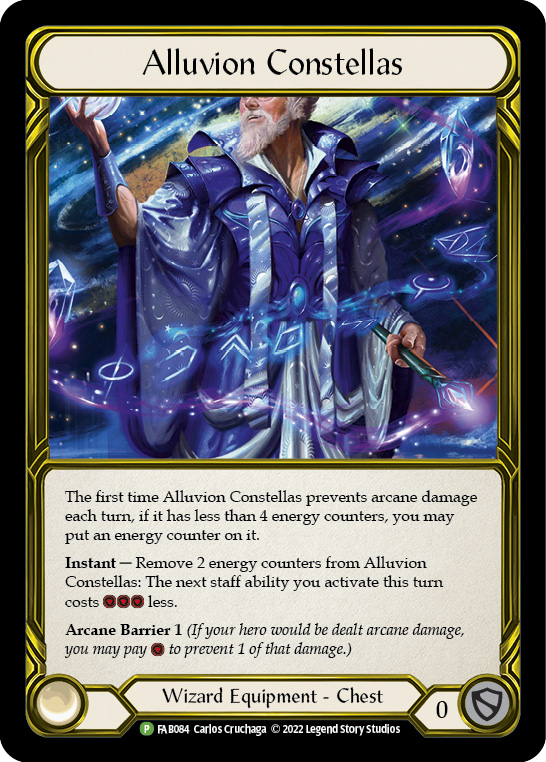
- Spellfire Cloak- If you don't think the match will last 3 turns (Ninja for example), then use this to instantly have access to a resource on the opponent's turn. Another great option with a similar effect is Threadbare Tunic.
- Metacarpus Node- Has Arcane Barrier. The effect of pay 1 pitch to increase the value of your arcane by 1 can be very potent. It's very powerful in this use, but it only has its ability for one turn.
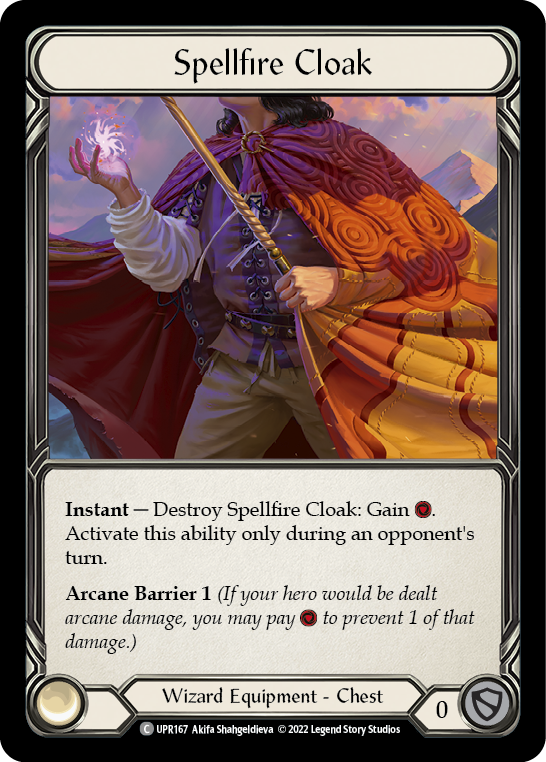
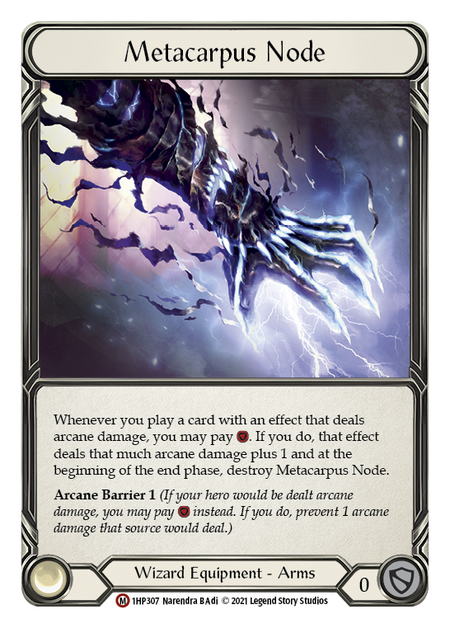
- Storm Striders- Has Arcane Barrier 2. There isn't a substitute here. Allows you to play your next Wizard non-attack as an instant. Activating this out of order can unintentionally use the effect on Storm Striders. Be careful that you are intentional with it's use! The power of Storm Striders is very strong.
- Ragamuffin's Hat- This swaps your last card in hand with one on top, giving you the option to put the top card or one in your hand on top or bottom of your deck. You can use it in a scenario to put your Tome of Aetherwind as your first banish, or to swap a leftover red for a blue and gain access to a few more pitch. The utility of this equipment gives the Kano many options. Ragamuffin's can also be used to put a power card like Blazing Aether from your hand and insert it as a banish target for maximum damage.
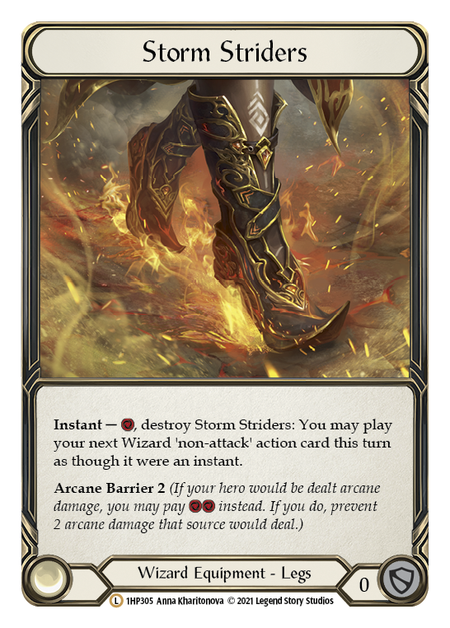

There are 2 common items that you will see in most Kano decks. Once these hit the field they make the matchup easier and in favor of the Kano. Keep these in mind.
- Energy Potion- More resources are always a great thing. This has been a strong item that has cycled in and out of the meta for all heroes since Welcome to Rathe. It needs no introduction and can add to compounding actions played on the Kano's sequence of events.
- Potion of Deja Vu- This lets you order your pitch back on top of your deck. This can be used to in many different and unique ways to expand your reach. You can pitch 2 blues and Tome of Aetherwind and then Potion of Deja Vu to make it so your first hit is the Tome, then play it to draw the 2 blues, and then there's another Kano and resource left on the stack. Another scenario is that you have 3 Sonic Booms in hand. You pitch to Storm Striders, Crucible, and play Aether Wildfire with Nodes to come in at 5 pitch. 3 Sonic Booms offer 6 pitch, 1 blue plus Tunic and Deja Vu will allow you to stack the Sonic Booms so that they hit each other in succession. That's just one very specific combination. What about Sonic Boom to Lesson and then tutor for Blazing? Wildfire to a Lesson put on top with Potion of Deja Vu also adds a ton of value.

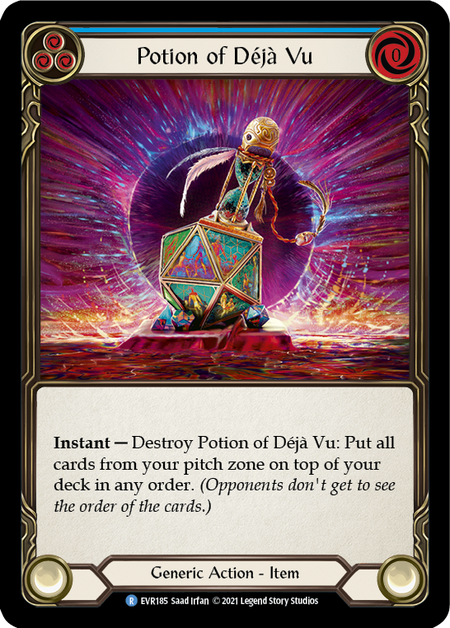
The Inner Part Out Loud
Ever see a Kano in the tank for minutes on end? What could they possibly be doing besides staring into nothing? Allow me to give away all of the secrets! (Sorry Kano players) Throughout the game Kano should be monitoring the opponent's cards. They should actively think about the opponent's pitch stack, and cards that have been pitched. Does the opponent have an arsenal? How long have they sat on it? What might be the reason why? Do I think they may be running Oasis Respite to combat a high damage turn? Are they running a low cost curve, or high?
As the Kano player, you should pay constant attention to the resources available to the player. For sake of math, I usually hedge that a card in a player's hand is worth 3 resources (depending on the deck I am playing against). When the turn starts, weigh the outcome of the opponent sending lethal damage. If the Kano player blocks, it will be harder to respond. (I don't think I can say that enough). Blocking efficiently is important in the match, but it has to be done appropriately.
Additionally, Kano should be making a mental note of damage done, and constantly adjust for what they believe the opponent's peak and average damage to be. The main thing to note as Kano is not to block if you plan on having a big turn.
Every Kano is hoping to reach that explosive response, but most games in Flesh and Blood do not go to second cycle. Kano will need to ask several questions....
- How many blues in my deck?
- How many reds?
- How many of each cost?
- How many of each cost are in my graveyard and pitch?
- How many cards have I seen?
- What haven't I seen?
- What are the percentages of me getting the desired cards?
Once Kano's in the last 20 cards of the deck, they can calculate the probably of getting a 0-cost by looking at the known information. That extra damage could be the difference in winning the game.
The Big Wildfire
Since we are talking about numbers, let's explore the big go-off turn using Aether Wildfire. With Kindle coming out, there are tons of new combinations - but it's important to note that since Kindle isn't a non-attack, Wildfire will not buff it; however, the reverse will work. Since it's still new and for the sake of this piece, let's not focus with it at the moment.
The equation we are working with is:
X=damage done by Aether Wildfire
X+Lesson in Lava(3)+X +Blazing Aether+X
Let's break it down and see the difference with a few numbers:
X=6
6+3+6+15+6=36
X=5
5+3+5+13+5=31
X=4
4+3+4+22+5= 27
X=3
3+3+3+9+3=21
X=2
2+3+2+7+3=17
X=1
1+3+1+5+1=11
X=0
0+3+3=6
You can see the drastic sliding scale of the damage done. While this is a standard Wildfire>Lesson>Blazing combo, there are plenty of other options to be had. Anywhere in that equation, if you add another blue 0-cost, you typically send X+1 and then the equation adds (X+1)2, where the damage is doubled due to a Blazing Aether. The standard equation where Aether Wildfire deals 6 damage is then added up to a 50 damage turn. I'll leave all of the nitty gritty math and crazy combos up to you to figure out.
A Wizard's Role
As a Wizard, Kano has always had an interesting spot within the meta. A meta that is purely focused on aggression or control can really hurt Kano's chances of being relevant. The meta of Heavy Hitters places him in an interesting position. Many decks can now act from a position of value. This means they can against most decks block with 2 cards and equipment and still send back respectable damage. Since Kano does damage through arcane, it's likely an opponent will use 1 blue to prevent damage through arcane barrier on their turn. Then, on their turn if they send an attack using 2 cards then that leaves 1 card left over for defense. What is the likelihood that if they blocked with a blue the previous turn, then pitched a blue to attack with a red this turn that the last card is also blue? This situation is what makes Kano very strong in the current meta.
Heroes like Katsu who are able to hit the gas right from the get-go can provide a more difficult scenario through Kano to act in. While there are a number of heroes with strengths against Kano to consider, each have their own weaknesses. Katsu's ability is to discard a card and search for a card. He doesn't draw the aforementioned card, but it gets played from banish. This can create an opening, because Katsu may be without defense if you try to go off. Prism has angels with ward, but if you can keep them clear you'll likely be able to push through her low life total. Boltyn has AB 2 and spellvoid and doesn't really run any blues. Azalea pushes fast and insane damage and has AB2, but her deck is mostly comprised of reds which don't give her much room to block. Every hero and their own strength, and their own weakness versus the Wizard of Dracai.
As can be experienced with any card game, metas do shift. Since his inception, Kano has always provided the ability to be a strong meta check. He weaves in where others think they don't need to bother. Starvo was incredibly strong, but without AB Kano could walk over him. He also showed in his making calculations a lot safer and simpler if he did have AB. Dromai was a hero that could summon endless AB, but since she ran mostly red-striped pitch it put her in a difficult spot against Kano. Classes that only use 1 action point typically struggle into Kano, but classes that try to wide and fast will not have the resources to get through safely. If you are playing a slower deck and can pitch stack Kano will win. If you are playing an aggro deck and cannot find space for patience then he will also break through your defense. Kano will always play to your blindside, and rarely attempt a head on fight.
I didn't speak about all of the options. Brainstorm Kano exists, as does Muscle Kano (or Kano with attack actions) and more. They likely won't be in the forefront of your Pro Quests at this time, but there may be some warriors out there carrying the flag for their favorite variant.
At the end of the day, Kano's most useful tool is information. None of his attacks by themselves do much of anything to worry about. Compound several cards together and they have the ability to be quite lethal quite fast. Kano does demand a sense of being in the game and not on autopilot for the majority of the game. The best advice for a prospecting Kano player is to let the game happen around you and not to you. Meaning, find ways not to feel like the center of attention during a vicious onslaught of 10 damage turns. Try to look for your options, evaluate what is best, and make decisions accordingly. Be mindful and don't suffer on hits- use this as an opportunity to pitch to Kano's ability if you need. Every card you have counts. Keep calm and Kano on!
Thanks to Blazing for Lethal for his helpful Kano insight. If you're looking for more discussion of Instant windows and how to play your best into Kano, watch for Blazing's upcoming article on how to beat Kano!


